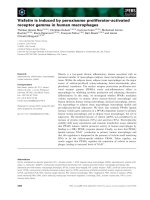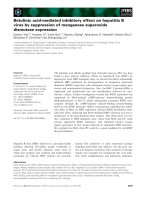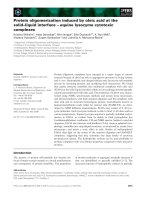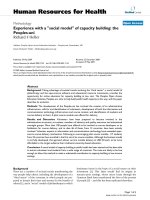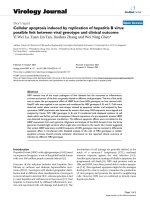Báo cáo sinh học: " Cellular apoptosis induced by replication of hepatitis B virus: possible link between viral genotype and clinical outcome" pptx
Bạn đang xem bản rút gọn của tài liệu. Xem và tải ngay bản đầy đủ của tài liệu tại đây (417.05 KB, 5 trang )
BioMed Central
Page 1 of 5
(page number not for citation purposes)
Virology Journal
Open Access
Short report
Cellular apoptosis induced by replication of hepatitis B virus:
possible link between viral genotype and clinical outcome
Yi Wei Lu, Tuan Lin Tan, Jianhua Zhang and Wei Ning Chen*
Address: School of Chemical and Biomedical Engineering, Nanyang Technological University, 62 Nanyang Drive, 637459, Singapore
Email: Yi Wei Lu - ; Tuan Lin Tan - ; Jianhua Zhang - ;
Wei Ning Chen* -
* Corresponding author
Abstract
HBV remains one of the major pathogens of liver diseases but the outcomes as inflammation,
cirrhosis and cancer of the liver are greatly related to different viral genotypes. The aim of this study
was to assess the pro-apoptotic effect of HBSP from three HBV genotypes on liver derived cells.
HepG2 cells were applied in our system and transfected by HBV genotype A, B, and C. Cells were
observed under phase contrast microscope, stained by apoptosis marker and analyzed by flow
cytometre. HBSP expression was detected by western blot assay. BH3 sequences were aligned and
analyzed by Vector NTI. HBV genotypes A, B, and C transfected cells displayed evidence of cell
death which was further proved as apoptosis. Natural expression of a pro-apoptotic protein HBSP
was detected during genomes transfection. The different apoptotic effects were correlated to the
HBSP expression from each genome. Alignment and analysis of the BH3 domains from the three
genomes revealed slight variance which might also contribute to the result. Our results suggested
that variant HBSP expression and BH3 sequence of HBV genotypes may be involved in differential
apoptotic effect in transfected cells. Detailed analysis of the role of HBV genotypes in cellular
apoptotic process should provide molecular information on the reported clinical outcome of
infection by different HBV genotypes.
Introduction
Hepatitis B virus (HBV), with eight genotypes (A-H) based
on sequence divergence, is one of the global health threats
with over 400 million people currently infected [1].
Outcome of the infection includes viral hepatitis, liver
fibrosis or cirrhosis and ultimate hepatocellular carci-
noma (HCC). Genotypes with distinct geographic distri-
bution lead to different clinic manifestations. Genotype B
is more inclined to develop HCC, whereas genotype A and
C cause hepatitis and cirrhosis more that cancer [2]. Viral
hepatitis is characterized by diffused inflammatory reac-
tion and associated with cell damage and death [3]. The
mechanisms of cell damage are generally defined as the
result of a cytotoxic-T lymphocyte (CTL) mediated
immune response against the viral infection [4,5].
Another typical process causing cell death is apoptosis, the
programmed cell death [6]. HBV viral proteins, such as
HBx and HBSP, have been proved able to induce apopto-
sis [7,8]. This regulated apoptosis might be the strategies
developed by virus in order to maximize the production
of virus progeny and promote the spread to neighboring
cells. However, HBV was yet confirmed to directly cause
hepatocyte death.
Published: 31 October 2007
Virology Journal 2007, 4:117 doi:10.1186/1743-422X-4-117
Received: 5 September 2007
Accepted: 31 October 2007
This article is available from: />© 2007 Lu et al; licensee BioMed Central Ltd.
This is an Open Access article distributed under the terms of the Creative Commons Attribution License ( />),
which permits unrestricted use, distribution, and reproduction in any medium, provided the original work is properly cited.
Virology Journal 2007, 4:117 />Page 2 of 5
(page number not for citation purposes)
It has been reported that the mitochondria-dependent
apoptotic pathway which is governed by Bcl-2 family of
proteins is involved in the development of liver diseases
[9,10]. The Bcl-2 family of proteins is defined as the key
regulator of apoptosis in the mitochondria-dependent
way. They consist of both suppressors and promoters of
apoptosis. Four conserved domains within the Bcl-2 fam-
ily of proteins have been identified through sequence
comparisons and named as Bcl2-homology (BH)
domains 1–4, particularly, the BH3 domain promotes cell
death in most occasions [11]. Recent reports have identi-
fied Bcl2-homology domain 3 (BH3) in HBx and HBSP
which cast light on how the HBV viral proteins are
involved in apoptosis at molecular level [7,8]. The apop-
tosis induced by the viral proteins might help the dissem-
ination of viral particles with less host immune
neutralization.
In this study we reported evidence of direct cell death
caused by HBV genome A, B and C after transfection in
HepG2 cells. The transfected cells showed characteristics
of cellular apoptosis supported by FACS analysis. Further
investigation identified the natural expression of HBSP in
HBV genome transfected cells. The observed difference in
apoptotic effect caused by the three HBV genotypes
revealed different HBSP expression in them. BH3 domain
sequence analysis revealed the existence of some variance
in the three HBSP proteins which might contribute to the
result. The significance of our findings was discussed.
Materials and methods
Cell culture and transfection
HepG2 cells (ATCC, USA) were cultured in DMEM (Gibco
Dulbecco, Invitrogen Inc., USA) with 5% fetal bovine
serum (Invitrogen Inc., USA) and 5% CO
2
. Effectene
transfection reagent was applied to transiently expressed
proteins in HepG2 cells. The cells were tranfected with
plasmids when 50% confluency was reached. Transfected
cells were maintained at 37°C and examined according to
the experiments.
FACs assay
Vector pcDNA3.1(+) containing the replicative HBV
genome A, B, and C were transiently transfected into 5 ×
10
5
HepG2 cells, respectively. HepG2 cells transfected
with empty vector and cells treated by 50 µM cisplatin for
16 hr were set as (-) and (+) controls. Transfected cells
were collected at 24 hr and 48 hr after incubation and ana-
lyzed by Apoalert™ annexin-V kit (BD, Biosciences, USA).
Cells were rinsed in 100 µl binding buffer and stained
with 5 µl annexin-V-FITC and 10 µl propidium iodide
(PI). Samples were analyzed on FACS station to determine
the apoptotic cell portion after 30 min incubation.
Western blot analysis
HBSP polyclonal anti-serum was acquired by boosting
rabbit using an internal HBSP peptide:
CDLNLGQDQQQPVRD (Biogenes, Germany). HBSP
protein was detected by primary anti-HBSP antibody in
1:1000 dilution and secondary anti-rabbit antibody con-
jugated with horseradish peroxidase (Pierce, USA) in
1:5000 dilution. Following ECL detection (Pierce, USA)
membrane was developed by Kodak E&D system (Kodak,
USA).
Alignment analysis
HBSP amino acid sequences were analyzed by using Vec-
tor NTI9. Result was generated and compared with other
BH3 domains.
Results and discussion
FACS results
A cell-based system for HBV genome A, B, and C replica-
tion was generated by cloning the linearized genome in
the vector pcDNA3.1 [12]. It has been shown to produce
replicative viral particles into the culture medium [13].
This system was selected to investigate the effect of HBV
genomes on the cells.
Recent reports have suggested a new concept that HBV
replication is associated with cell death in contrast to the
widely accepted non-cytopathic character of HBV [8]. A
direct role of viral proteins in apoptosis was also con-
firmed [7,8,14]. Careful examination of HBV genome A, B
and C transfected cells under light microscopy showed
rounded up and detached cells which are apoptotic signs.
Such morphologies were not observed in normal HepG2
cells and cells transfected with empty plasmid, however,
was similar to those cisplatin (a known chemical causes
apoptosis) treated cells (data now shown). To identify the
observed cell death, FACS was used which is based on the
observation that apoptotic cells show externalization of
phophatidylserine (PS) on cell membrane [15]. Double
staining with FITC (FL1-H) and PI (FL2-H) would indi-
cate apoptotic cells in the bottom-right square of FACS
profile as shown in Fig. 1. The results indicated there were
more apoptotic cells in the three HBV genomes trans-
fected cells than normal cells at both time point (24 hr
and 48 hr). As the incubation prolonged, there was an
increase of apoptosis cells in the 48 hr (Fig. F, G, H) sam-
ples than the 24 hr samples (Fig 1C,D,E). Specially,
genome B displayed a stronger pro-apoptotic effect than
genome A and C at both time points (Fig D, G). Our data
therefore indicated that HBV genomes were able to induce
cell death which is consistant with other viruses capable of
inducing cell death. Furthermore, genome B has stronger
pro-apoptotic ability than genome A and C.
Virology Journal 2007, 4:117 />Page 3 of 5
(page number not for citation purposes)
HBSP expression
HBSP has been found in HBV infected liver and shown to
induce apoptosis through a hitherto unknown mecha-
nism [16,17]. It was also indicated to contain a BH3
domain in the N-terminal and naturally expressed during
HBV infection as mRNA of HBSP was detected [8]. How-
ever, direct proof of HBSP expression during HBV replica-
tion was not characterized. In this study, we used an anti-
HBSP antibody (as described in Materials and methods)
to detect its expression during HBV genome transfection.
To this end, HepG2 cells transfected with the replicative
HBV genomes were collected at 48 hr and detected by
western blot assay. Results showed detection of HBSP in
all the HBV genotypes A, B and C (Fig 2. lane 1, 2, 3).
More important, the HBSP expression level in cells
showed genome B (Fig 2. Lane 2) had the most abundant
HBSP than genome A and C (Fig 2. lane 1, 3). As an inter-
nal control, the actin expression in samples was almost
equal. This result indicated that the HBSP expression in
genotype B was more abundant than those in genotype A
and C thus induced higher apoptotic effect as shown in
Fig. 1. Our data therefore explained that HBSP was natu-
rally expressed in HBV replication and its expression con-
tributed directly to the observed apoptotic effect caused by
HBV genomes.
Alignment analysis of BH3 domain in HBSPs
As indicated, the HBSP expression might contribute to the
viral pro-apoptotic activity. Depending on the slight
nuclear acid variance in different genotypes, there raised
another possibility that HBSPs might differ in sequence.
We aligned the three HBSPs' amino acid sequence and
revealed some difference in their BH3 domains (spanning
Natural expression of HBSP in HBV replicationFigure 2
Natural expression of HBSP in HBV replication. HBV
genome A, B, and C were transfected into HepG2 cells. Cells
lysate were detected by anti-HBSP and anti-actin antibodies
at 48 hr post-transfection. Lane 1, 2, 3 indicated HBV
genome A, B, and C, respectively.
Flow cytometry analysis of apoptotic effect by HBV genome A, B, and CFigure 1
Flow cytometry analysis of apoptotic effect by HBV genome A, B, and C. HepG2 cells were transiently transfected
with HBV genome A, B, and C and incubated for 24 h (panel C, D, E, respectively) and 48 h (panel F, G, H, respectively) before
collected and applied to FACS assay. Cells transfected with empty vector pcDNA3.1 (panel A) and cells treated with cisplatin
(panel B) were used as (-) and (+) controls. Cells were labeled by annexin-V-Fitc (FL1-H) and propidium iodide (FL2-H). In each
panel, the lower right square (LR) indicates the number of apoptotic cells' portion. Data: LR: A:0.62%, B: 17.32%, C: 2.53%, D:
2.69%, E:1.61%; F: 9.18%, G: 16.13%, H: 6.86%
Virology Journal 2007, 4:117 />Page 4 of 5
(page number not for citation purposes)
from aa 21–35, Fig. 3). According to the BH3 consensus,
the Leu
21
, Leu
25
, Arg
27
, Leu
28
, Ala/Gly
29
, Asp
30
, Glu
31
and
Asp
32
are the most conserved sites [18]. HBSPs shared
most of the conserved sites except the acidic aa 31 and 32
which are supposed to be important for electrostatic inter-
action between Bcl-2 family proteins. Genotype B HBSP
possesses both E and D, whereas Genotype A and C have
only one each as indicated in blue. This result proposed a
possible molecular clue that HBSP genotype B has
stronger pro-apoptotic effect than HBSP genotype A and C
due to the variance in their BH3 domain. The variance in
their HBSP BH3 domain also revealed some clue of differ-
ent pro-apoptotic property. In BH3 domain, the Leu
21
,
Leu
25
and Leu
28
form the hydrophobic side of the BH3 α-
helix to interact with the hydrophobic cleft formed by
other anti-apoptotic members of Bcl-2 family. Mean-
while, Arg
27
, Asp
30
and Glu
31
are important to form elec-
trostatic interaction inside the cleft [18]. Genotype B
HBSP is well conserved, including position 31 and 32,
while Genotype A has Glu
31
and genotype C possesses
Asp
32
. This result indicated another possibility how the
genotype B caused higher apoptosis.
This study is first to describe HBV genotype A, B, and C
lead to apoptosis in HepG2 cell and the slight difference
was related to HBSP expression and its property. During
the last two decades, it has been widely believed that HBV
does not directly cause cell death in host cells [4,5]. Our
finding raised the idea that HBV can cause apoptosis with
its viral proteins [7,8]. For viruses to avoid the host clear-
ance during the early infection stage they have evolved
anti-apoptotic proteins to prevent the host cell from elim-
ination, such as BHRF1 of EBV and E1B19k of Adenovirus
[19,20]. On the other hand, viruses also developed pro-
apoptotic mechanisms in the late stage of infection to
break host cell and promote the spread of viral progeny,
like VPR of HIV [21]. It is therefore not surprising that
HBV causes apoptosis. HBV chronic infection is consid-
ered the main cause of liver cirrhosis and cancer [22]. HBV
Genotype B is more related to HCC, whereas genotype A
and C are more inclined to cause cirrhosis [2]. This may
be related to the severity of persistent HBV infection
which determines the infected cell amount. Our finding
of the genotype B expresses more HBSP than the other two
genotypes and caused higher apoptotic effect supported
this hypothesis since it facilitates the spread of viral prog-
eny to infect more healthy cells. Considering the high
regeneration capacity of liver cells, it is also possible that
an extensive apoptosis would result in a higher level of
liver cell proliferation in a regeneration effort. Such an
increase in cell division may perturb the normal cell cycle
control, resulting in an accumulation of mutations in the
genome of progeny cells which ultimately contribute to
HCC development. In conclusion, the present study
showed the important role of HBSP in HBV induced
apoptosis and it determined the variant outcome of differ-
ent genotypes which might be related to the clinic out-
comes.
Authors' contributions
YWL carried out the experiments on apoptosis and con-
tributed to the first draft of manuscript. TLT contributed
in cloning of Bcl-2 family of genes, and helped in Western
blot analysis. JZ contributed to cell culture work. WNC
initiated the project, interpreted experimental data and
finalized the manuscript for submission.
Acknowledgements
This work was supported by grant 03/1/22/18/229 (WN Chen) from the
Biomedical Research Council, Agency for Science, Technology and
Research, Singapore. YW Lu and TL Tan were recipients of the graduate
scholarship from Nanyang Technological University.
References
1. Zuckerman AJ: More than third of world's population has been
infected with Hepatitis B virus. BMJ 1999, 318:1213.
2. Enomoto M, Tamori A, Nishiguchi S: Hepatitis B virus genotypes
and response to antiviral therapy. Clin Lab 2006, 52(1–2):43-47.
3. Lau JY, Xie X, Lai MM, Wu PC: Apoptosis and viral hepatitis,
Semin. Liver Dis 1998, 18:169-176.
4. Lowin B, Hahne M, Mattmann C, Tschopp J: Cytolytic T-cell cyto-
toxicity is mediated through perforin and Fas lytic pathways.
Nature 1994, 370:650-653.
5. Brechot C: Pathogenesis of hepatitis B virus-related hepato-
cellular carcinoma: old and new paradigms. Gastroenterology
2004, 127(Suppl 1):S56-S61.
6. Adams JM, Cory S: The Bcl-2 family: arbiters of cell survival. Sci-
ence 1998, 281:1322-1326.
7. Lu YW, Chen WN: Human hepatitis B virus X protein induces
apoptosis in HepG2 cells: role of BH3 domain. Biochem & Bio-
phy Res Com 2005, 338:1551-1556.
8. Lu YW, Tan TL, Chan V, Chen WN: The HBSP gene is expressed
during HBV replication, and its coded BH-3-containing
spliced viral protein induces apoptosis in HepG2 cells. Bio-
chem & Biophy Res Com 2006, 351:64-70.
9. Chen GG, Lai PB, Chan PK, Chak EC, Yip JH, Ho RL, Leung BC, Lau
WY: Decreased expression of Bid in human hepatocellular
carcinoma is related to hepatitis B virus X protein. Eur J Can-
cer 2001, 37:1695-1702.
10. Ehrmann J, Galuszkova D, Krc I, Jezdinska V, Vojtesek B, Murray PG,
Kolao Z: Apoptosis-related proteins, Bcl-2, Bax, Fas, Fas-L
and PCNA in liver biopsies of patients with chronic hepatitis
B virus infection. Oncol Res 2000, 6:130-135.
Alignment of BH3 domains of HBSPsFigure 3
Alignment of BH3 domains of HBSPs. Alignment of the
BH3 domains revealed the three genotypes share the same
conserved amino acid 21–30. BH3 domain is characterized by
consensus at position 21, 25, 27, 28, 29, 30, 31 and 32 which
are required for interaction. HBSPs differed mainly at posi-
tion 31 and 32. Genotype B has both of them conserved
while A and C has one each (blue color).
21 31 32 35
HBSP A BH3 LEEELPRLADADLHR
HBSP B BH3 LEEELPRLADEDLNH
HBSP C BH3 LEEELPRLADEGLNR
Publish with BioMed Central and every
scientist can read your work free of charge
"BioMed Central will be the most significant development for
disseminating the results of biomedical research in our lifetime."
Sir Paul Nurse, Cancer Research UK
Your research papers will be:
available free of charge to the entire biomedical community
peer reviewed and published immediately upon acceptance
cited in PubMed and archived on PubMed Central
yours — you keep the copyright
Submit your manuscript here:
/>BioMedcentral
Virology Journal 2007, 4:117 />Page 5 of 5
(page number not for citation purposes)
11. Kelekar A, Thomson CB: Bcl-2 family proteins: the role of the
BH3 domain in apoptosis. Trends Cell Biol 1998, 8:324-329.
12. Chen WN, Oon CJ, Toh I: Altered antigenicities of hepatitis B
virus surface antigen carrying mutations outside the com-
mon "a" determinant. Am J Gastroenterol 2000, 95:1098-1099.
13. Oon CJ, Chen WN, Goh KT, Mesenas S, Ng HS, Chiang G, Tan C,
Koh S, Teng SW, Toh I, Moh MC, Goo KS, Tan K, Leong AL, Tan GS:
Molecular characterization of hepatitis B virus surface anti-
gen mutants in Singapore patients with hepatocellular carci-
noma and hepatitis B virus carriers negative for HBsAg but
positive for anti-HBs and anti-HBc. J Gastroenterol Hepatol 2002,
17(Suppl):S491-S496.
14. Lee AT, Ren J, Wong ET, Ban KH, Lee LA, Lee CG: The hepatitis B
virus X protein sensitizes HepG2 cells to UV light-induced
DNA damage. J Biol Chem 2005, 280:33525-33535.
15. Huang HL, Jeng KS, Hu CP, Tsai CH, Lo SJ, Chang C: Identification
and characterization of a structural protein of hepatitis B
virus: a polymerase and surface fusion protein encoded by a
spliced RNA. Virology 2000, 275:398-410.
16. Soussan P, Garreau F, Zylberberg H, Ferray C, Brechot C, Kremsdorf
D: In vivo expression of a new hepatitis B virus protein
encoded by a spliced RNA. J Clin Invest 2005, 105:55-60.
17. Soussan P, Tuveri R, Nalpas B, Garreau F, Zavala F, Masson A, PolS ,
Brechot C, Kremsdorf D: The expression of hepatitis B spliced
protein (HBSP) encoded by a spliced hepatitis B virus RNA
is associated with viral replication and liver fibrosis. J Hepatol
2003, 38:343-348.
18. Sattler M, Liang H, Nettesheim D, Meadows RP, Harlan JE, Eberstadt
M, Yoon HS, Shuker SB, Chang BS, Minn AJ, Thompson CB, Fesik SW:
Structure of Bcl-xl-Bak peptide complex: Recognition
between regulators of apoptosis. Science 1997, 275:983-986.
19. Kim ND, Chae HS, Oh ST, Kang JH, Park CH, Park WS, Takada K,
Lee JM, Lee WK, Lee SK: Expression of viral microRNAs in
Epstein-Barr virus-associated gastric carcinoma. J Virol 2007,
81(2):1033-1036.
20. Matsushita T, Okada T, Inaba T, Mizukami H, Ozawa K, Colosi P: The
adenovirus E1A and E1B19K genes provide a helper function
for transfection-based adeno-associated virus vector produc-
tion. J Gen Virol 2004, 85(Pt 8):2209-2214.
21. Kaminska M, Francin M, Shalak V, Mirande M: Role of HIV-1 Vpr-
induced apoptosis on the release of mitochondrial lysyl-
tRNA synthetase. FEBS Lett 2007, 581(16):3105-3110.
22. Liu CJ, Kao JH: Hepatitis B virus-related hepatocellular carci-
noma: epidemiology and pathogenic role of viral factors. J
Chin Med Assoc 2007, 70(4):141-145.
